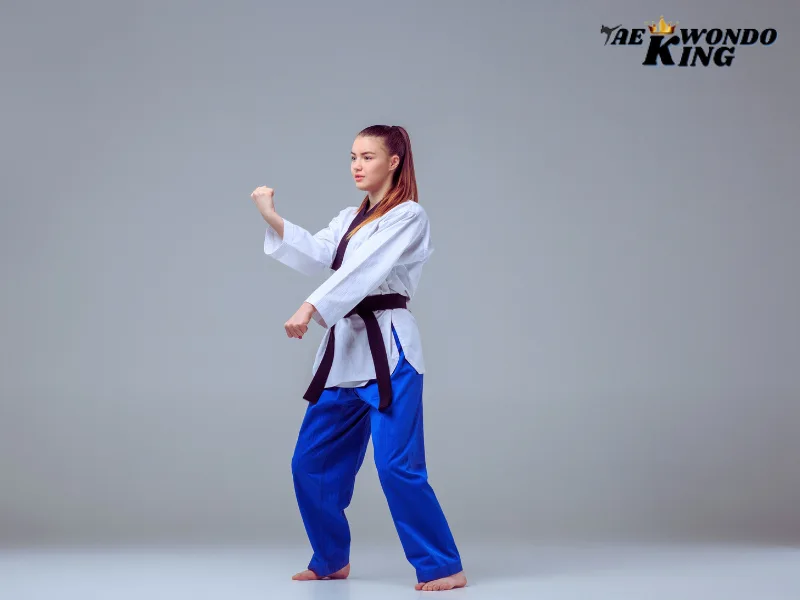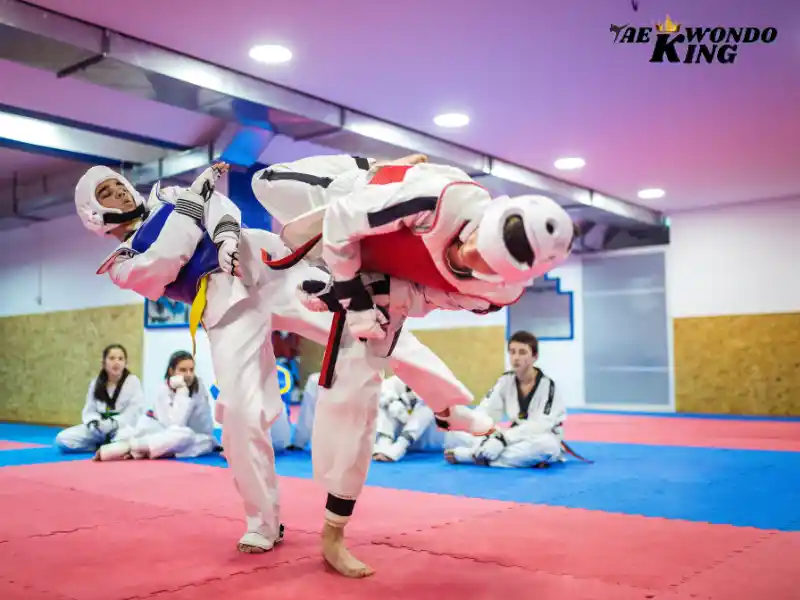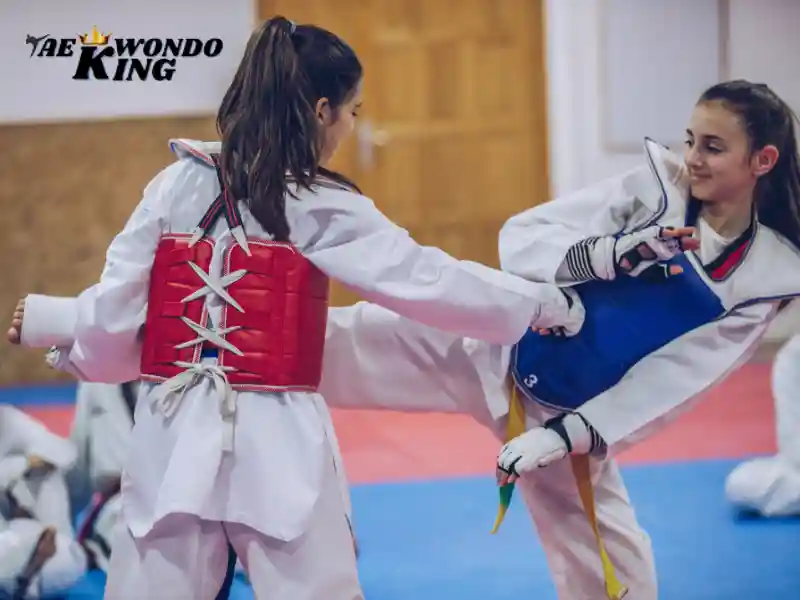
Both Muay Thai and Taekwondo are martial arts that focus on hand-to-hand combat. You can find plenty of articles comparing the two martial arts and there’s no right or wrong answer. But by taking some time to learn about both schools of fighting you can get a better understanding of why they’re so different and why each one has its own advantages and disadvantages.
In today’s world, you can find anything and everything online. But when it comes to training, the choices can seem overwhelming. You may even wonder which martial art is better: Taekwondo or Muay Thai.
To find out, I decided to research and compare the two, including the differences between Taekwondo and Muay Thai, the history of each martial art, the different classes and styles, and more. After doing so, I was surprised by what I found. But which one is best for a beginner? My research has uncovered the answer.
What is Muay Thai?

Muay Thai is the ancient art of Thailand, and there is no doubt that the technique of using our legs and feet in combination with our upper body and head has become a major part of our sports, fitness, and health.
Muay Thai is one of the oldest and most popular martial arts in the world. It’s a style of combat developed over centuries, and it focuses on kicks, knees, and elbows rather than blows. The sport is typically performed without a uniform or protective gear.
Instead, athletes wear only padded pants and gloves to protect themselves from injuries. Muay Thai is often considered a mixture of boxing and kickboxing. But unlike most other martial arts, Muay Thai is not a sport, it’s a martial art designed for self-defense.
What is Taekwondo?

Taekwondo is a traditional Korean martial art that involves kicking and punching. It is widely practiced today in schools, clubs, and fitness. Kukkiwon (widely known as the World Taekwondo Headquarters), The World Taekwondo Federation (WTF), the International Taekwon-Do Federation (ITF), and other systems (which include some persons receiving ranks from taekwondo organizations that predate the other two systems, e.g. the original Korea Taekwondo Association (KTA)) and United Taekwondo Association UWTA. Taekwondo is based on the philosophy of Confucius’s self-discipline, honor, respect for elders, diligence, and hard work. Taekwondo is a self-defense art that emphasizes both physical and mental skills to defend oneself.
Taekwondo’s purpose is to develop self-discipline, physical fitness, and self-defense while encouraging peace and harmony. Although there are many types of taekwondo, there are two main styles: traditional taekwondo and modern taekwondo. Modern taekwondo has been popularized in the West, making it the most common style. Taekwondo gi, taekwondo uniform, taekwondo belts, and taekwondo ranks are essential in taekwondo classes in a taekwondo academy. TKD takes only about 3 years to become a “black belt” under practicing traditional martial arts programs. There are some kids that are black belt at ages 5-7.
How does the Muay Thai Compare to Taekwondo?

Muay Thai is kickboxing that originated in Thailand, while taekwondo is a martial art that’s been around for centuries and originated in Korea. While the two sports are very similar and have a lot in common, there are some key differences between the two. For example, in Muay Thai, the fighters compete in three rounds, whereas in taekwondo, the athletes fight until one fighter is knocked down three times.
The two sports are remarkably similar, but Muay Thai focuses more on stand-up techniques, while Taekwondo is primarily a ground-fighting game. Both disciplines have a strong emphasis on self-defense and rely on the use of striking techniques. However, the rules are different and the training methods are distinct.
Taekwondo vs. Muay Thai? Which is Better for Health?

The two martial arts have both been used to train athletes for decades, but which is better for health? I did some research and found that they’re almost identical in terms of how much energy and strength they’ll burn (I assume you’re interested in the health benefits of each of these forms).
Both of them offer resistance training, which helps strengthen muscles. They’re also both cardio-based, so they’ll get your heart rate up, which helps keep your blood flowing and your body healthy.
There are some health benefits to both martial arts. The National Institute of Medicine has listed Taekwondo as an aerobic sport that requires moderate to vigorous physical activity for cardiovascular benefits and is a weight-bearing exercise for bone health.
Muay Thai is similar and can be considered a high-intensity workout with the added benefit of strength and power. Taekwondo is considered safe and a great workout for beginners.
Taekwondo vs. Muay Thai? Which is Better for Self-Defense?
Both martial arts are great for self-defense, but there are differences between them. These differences include things like the types of training, the rules, the equipment, and what your instructor is likely to emphasize. The two styles are very similar. Some people even say they are the same thing. But there are differences.
If you have no experience with either of these martial arts, you may not know that they both offer a variety of self-defense techniques. If you decide to learn taekwondo, you’ll can learn the full spectrum of self-defense, from kicking techniques to joint locks and even weapons training. Muay Thai, however, doesn’t provide all that many options for self-defense beyond punching and kicking, so you’ll only need to master those methods.
Summarize the advantages of each martial art

There are many reasons why people choose to learn martial arts. Some are looking for a new hobby or physical fitness activity. Others are trying to prepare for a job that requires strength and a high tolerance for pain.
There are many martial arts to choose from, and there are some that are better than others. Taekwondo and Muay Thai are both great martial arts that can help you achieve any of these goals. Here are some differences between Muay Thai and Taekwondo to help you decide which one is right for you.
They’re both sports, but they are very different in the kind of training they require. Muay Thai is an ancient form of martial arts with roots in Thailand. It is a full-contact sport with an emphasis on kicking and punching techniques.
The goal is to knock out your opponent as quickly as possible with little to no risk to yourself. On the other hand, Taekwondo is a more defensive form of martial arts. It is a highly technical sport. The goal of the sport is to keep your opponent from knocking you down with kicks and punches.
While each martial art has different techniques and benefits, each is designed to protect the fighter’s vital organs (especially the head) and incapacitate the opponent by any means necessary. Martial arts training emphasizes self-defense and may be practiced alone or in combination with physical exercise.
Muay Thai vs. Taekwondo? What are the disadvantages of each martial art?
The disadvantages of learning either Taekwondo or Muay Thai aren’t as clear-cut as many people think. Both martial arts are widely practiced in the United States and both are seen as sports. Many people view Muay Thai as a tough sport because of its emphasis on kicking and punching.
While this is certainly true, many other martial arts are just as tough, if not tougher. The key thing to consider is that any martial art is an excellent exercise for the human body. If someone is looking to get in shape, learn a new hobby or skill, or just improve their overall fitness level, they’ll be in good company with any of these martial arts.
They are both very effective in self-defense. But they differ in many ways. If you want to decide which is better, there are three main factors you should consider. You want to see if one is better than the other. One of those three factors is your time investment. A second factor is your training costs. A third factor is your risk tolerance.
Why Should You Try Taekwondo?

To start off, you can expect to be stronger than most of your peers. The workouts are highly intensive, and you’ll notice significant strength gains within only a matter of weeks. However, the discipline involved in practicing taekwondo can help you become a better person.
The art of taekwondo emphasizes self-discipline, respect for others, and respect for the rules of the sport. It teaches its practitioners to be calm under pressure, focus on the present, and act with honor.
Practicing taekwondo will not only give you a chance to improve your cardio and strength but also will sharpen your mental skills and help you achieve goals such as losing weight, gaining muscle, and improving your coordination. In addition, taekwondo is a very social sport that is full of fun and excitement. The training will definitely make you feel like a kid again, and you’ll have lots of fun doing it!
In conclusion,
Both disciplines are excellent martial arts. They provide good training for any level of athlete, whether you’re a recreational athlete looking for a fun workout or an elite athlete wanting to increase your strength, agility, and power.
However, I would suggest that Taekwondo is a much more efficient training for your physical and mental development. Both martial arts are great for athletes of all levels. But if you’re looking to add some flexibility and improve your overall athleticism, I would recommend that you focus on developing your body through Taekwondo.
FAQ
How can I achieve a black belt in Muay Thai and Taekwondo?
To achieve a black belt in Muay Thai and Taekwondo, you will need to follow a structured training program and dedicate yourself to consistent practice and hard work. Here are some steps you can take:
1. Find a reputable and certified martial arts school or instructor who specializes in Muay Thai and Taekwondo.
2. Enroll in regular classes and attend them consistently. It is important to be committed and disciplined in your training.
3. Practice outside of class to improve your skills. This can include shadowboxing, practicing kicks and punches, and working on your technique.
4. Set specific goals and work towards them. Progress through the various belt levels, mastering each level’s requirements before moving on to the next.
5. Stay physically fit and maintain a healthy lifestyle. Regular exercise, proper nutrition, and sufficient rest are essential for progress in martial arts.
6. Develop mental discipline and focus. Martial arts require concentration, perseverance, and mental toughness. Cultivate these qualities through meditation, visualization, and mental training exercises.
7. Participate in competitions and tournaments to challenge yourself and gain experience. This will help you gauge your progress and improve your skills.
8. Seek guidance and feedback from your instructor. They can provide valuable insights and correct any mistakes or weaknesses in your technique.
9. Be patient and persistent. Earning a black belt takes time and effort. Stay motivated, stay dedicated, and never give up on your goals.
Remember, the journey to a black belt is not just about the destination but about the personal growth and development you experience along the way. Enjoy the process and embrace the martial arts philosophy of continuous learning and self-improvement.
How can achieve a knockout in Taekwondo and Muay Thai?
Achieving a knockout in Taekwondo and Muay Thai requires a combination of technique, accuracy, and power. Here are some general tips:
1. Develop proper technique: Focus on refining your kicks, punches, and strikes. Practice regularly to improve your precision and speed.
2. Target vulnerable areas: Aim for the chin, jaw, temple, or liver as these areas are more likely to result in a knockout. However, always prioritize safety and respect for your opponent.
3. Generate power: Work on building strength and power in your strikes. This can be achieved through conditioning exercises, such as weight training and resistance training.
4. Timing and speed: Learn to time your strikes effectively and deliver them with speed. Catching your opponent off guard can increase the chances of a knockout.
5. Practice combinations: Combine different techniques to create effective combinations. For example, set up a high kick with a jab or follow a punch with a powerful roundhouse kick.
6. Be patient and strategic: Knockouts don’t always happen quickly. Stay focused, read your opponent’s movements, and look for openings to deliver a powerful strike.
Remember, safety should always be a top priority. Proper training, supervision, and respect for your training partners or opponents are essential.
How to a strong clinch in Muay Thai and Taekwondo?
To improve your clinch in Muay Thai and Taekwondo, follow these tips:
1. Stance: Maintain a strong and balanced stance with your feet shoulder-width apart and slightly bent knees.
2. Grip: Use a firm grip with your hands around your opponent’s neck or upper body. In Muay Thai, you can also use the “plum” position by gripping the back of your opponent’s head.
3. Control: Manipulate your opponent’s movements by using your arms and body weight to control their balance and position.
4. Positioning: Get close to your opponent and establish a strong connection using your hips and core strength.
5. Balance and leverage: Focus on maintaining your own balance while disrupting your opponent’s balance. Use your body weight and leverage to gain an advantage.
6. Techniques: Incorporate knee strikes, elbow strikes, sweeps, and takedowns to make your clinch more effective.
7. Practice: Regularly train with a partner or under the guidance of a qualified instructor to improve your clinching skills and overall technique.
How to power in Taekwondo kicks?
To generate power in Taekwondo kicks, there are several key factors to consider:
1. Proper Technique: Focus on mastering the correct form and execution of the kick. This includes maintaining balance, using the correct muscle groups, and ensuring your body is properly aligned.
2. Flexibility and Strength: Regular stretching and conditioning exercises will help improve your flexibility and strength, enabling you to generate more power in your kicks.
3. Hip Rotation: Power generation starts from the hips. Rotating your hips and utilizing the full range of motion will add significant force to your kicks. Practice hip rotation exercises to develop this skill.
4. Speed: Combining speed with technique is crucial for powerful kicks. Work on increasing your leg speed through drills and exercises that focus on quick and explosive movements.
5. Core Stability: A strong core is essential for generating power in kicks. Strengthen your abdominal and lower back muscles through exercises like planks, crunches, and back extensions.
6. Practice: Regular practice and repetition are vital to improving your kicking power. Focus on quality technique and gradually increase your speed and strength over time.
Remember, power in Taekwondo kicks comes from a combination of technique, strength, flexibility, speed, and core stability. Consistent training and dedication will help you develop stronger and more powerful kicks.
How to achieve success in Taekwondo and Muay Thai competitions?
To achieve success in Taekwondo and Muay Thai competitions, here are some tips:
1. Train regularly: Consistent training is essential to improve your skills, technique, and physical fitness.
2. Set specific goals: Have clear goals for each competition and work towards them through focused training.
3. Develop a strong mindset: Mental toughness and resilience are crucial in competitive martial arts. Stay focused, motivated, and confident.
4. Study your opponents: Research and analyze your opponents’ fighting styles, strengths, and weaknesses to develop effective strategies.
5. Work on your technique: Practice and perfect your techniques, including kicks, punches, blocks, and footwork. Regularly spar and practice with experienced partners.
6. Stay physically fit: Conditioning and strength training are vital to endure the physical demands of competitions. Work on stamina, flexibility, and overall fitness.
7. Seek guidance from experienced coaches: A skilled coach can provide valuable insights, correct your mistakes, and help you develop effective game plans.
8. Participate in tournaments and competitions: Regularly compete to gain experience, learn from your successes and failures, and improve your performance under pressure.
9. Maintain a healthy lifestyle: Proper nutrition, sufficient rest, and recovery are essential for optimal performance and injury prevention.
10. Stay committed and dedicated: Success in martial arts competitions requires patience, perseverance, and a long-term commitment to continuous learning and improvement.

Founder, Owner, and CEO of TaekwondoKing.
He is one of the top 100 martial artists in the World and among the top 20 referees in Bangladesh.
Ehatasamul Alom is an esteemed Kukkiwon Certified Taekwondo 3rd Dan Black Belt with over 15 years of experience in this dynamic martial art. Born in Rajshahi, Bangladesh, Ehatasamul’s journey with Taekwondo began at the tender age of seven. His passion led him to compete at national and international levels, where he has bagged numerous awards and honors. He is also a member of the Taekwondo National Referee Panel.
With a Bachelor’s degree in Sports Science from the prestigious Rajshahi University, Ehatasamul has a deep understanding of the technical and scientific aspects of martial arts and some other martial arts.
In 2022, Ehatasamul created the “TaekwondoKing.com” to share his knowledge, Free Resources, Values, and Real experiences. His articles focus on Taekwondo training techniques, competition strategies, Sport Products Reviews, and the art’s rich history and philosophy. He also writes about the importance of mental fortitude and discipline, key aspects of his teaching philosophy. He has already launched many sports, Taekwondo, and health-related Free online tools. His goal is to inspire both beginners and seasoned practitioners worldwide through insightful and engaging content.
If you need any help, contact Ehatasamul Alom at any time.




